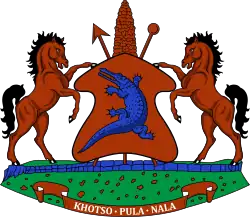Senate Ntlong ea Mahosana | |
|---|---|
 | |
| Type | |
| Type | of the Parliament of Lesotho |
| History | |
| Founded | 1965 |
| Leadership | |
Mamonaheng Mokitimi since 11 July 2017 | |
| Structure | |
| Seats | 33 |
Length of term | 5 years |
| Meeting place | |
 | |
| Parliament building in Maseru | |
| Website | |
| senate.parliament.ls | |
 |
|---|
29°19′22″S 27°29′33″E / 29.322739542481237°S 27.49252454519462°E
The Senate of Lesotho (Sotho: Ntlong ea Mahosana) is the upper chamber of the Parliament of Lesotho, which, along with the National Assembly of Lesotho (the lower chamber), comprises the legislature of Lesotho.[1]
Bicameralism in Lesotho is specifically modeled after the Westminster system of the United Kingdom,[2] having an upper house weaker than the lower.[3] As such, the Senate holds less power than the National Assembly; it cannot initiate legislation, it does not appoint the Prime Minister, and it does not participate in motions of confidence. The Senate's consent is required to amend certain clauses of the constitution, and for a bill to become law, it must be passed by both chambers of Parliament.[4]
The current Senate has a total of 33 members. 22 are hereditary tribal chiefs who perform executive functions for their respective communities and 11 are nominated by the King on the Prime Minister's advice and generally align with the King in their legislative behavior.[5] Members serve five-year terms. Senators may not serve simultaneously as members of the National Assembly.[6]
Mamonaheng Mokitimi is the current president of the Senate. She succeeded Prince Seeiso Bereng Seeiso.
See also
References
- ↑ Senate of Lesotho. "Senate of the Kingdom of Lesotho". Retrieved 11 February 2019.
- ↑ Macartney, W. J. A. (1969-12-01). "African Westminster? The Parliament OF Lesotho". Parliamentary Affairs. 23 (1969dec): 121. doi:10.1093/oxfordjournals.pa.a051517. ISSN 0031-2290.
- ↑ 'Nyana, Hoolo (2019). "Bicameralism in Lesotho: A review of the powers and composition of the second chamber" (PDF). Law Democracy & Development. 23: 19. Retrieved 8 December 2020.
- ↑ 'Nyana 2019, p. 20.
- ↑ Nwafor 2013, p. 59: "The composition of the parliament is very instructive when viewed in the context of separation of powers: the King, a chief executive in his own right; a Senate comprised of the principal chiefs, who perform mostly executive functions in their respective communities; and eleven persons nominated by the King, who mostly owe allegiance to the King in the discharge of their legislative functions."
- ↑ Nwafor, Anthony O. (2013). "The Lesotho Constitution and Doctrine of Separation of Powers: Reflections on the Judicial Attitude". African Journal of Legal Studies. 6 (1): 58–59. doi:10.1163/17087384-12342020.